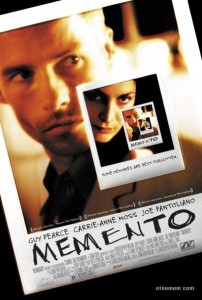
Our guest blogger today is Tillery Johnson. Born and raised in rural North Carolina, Tillery graduated from UNC-Chapel Hill in 2008 where he studied English and Creative Writing. These days, he is a comedian, musician, and aspiring screenwriter living in Hollywood. You can occasionally see him performing musical stand-up and improv on stage at Improv Olympic West (where one of his teams is reviving the “Improvised Movie” later this fall), Upright Citizens Brigade, and various comedy clubs around Los Angeles with a group called Monkey Butler. Access his blog here.
And now, drumroll please, as Tillery — with a few added comments from Cat! Ben Frahm, who found this breakdown “spot-on” — shows how Christopher Nolan’s Memento hits the beats:
Opening Image: Leonard (Guy Pearce) shoots Teddy (Joe Pantoliano) in the head. Ben adds:
Before we even see him shoot Teddy, we see a picture of Teddy, bloodied, and we watch a Polaroid picture develop backwards, which help set up the theme and mechanics of the movie.
Theme Stated: How can we know where we’re going unless we know where we’ve been? And how can we be sure we are who we say we are? Nothing is as it seems. If we’re constantly changing, how can we ever know who we are right now?
Set-Up: Leonard lacks the ability to form new memories, so he’s in a constant state of confusion, a sort of memory purgatory. He wants Teddy to beg

for his wife’s forgiveness, so we understand this is somehow related to vengeance. We also learn that Teddy was helping Leonard; now we wonder why he kills him. And we’re introduced to the name Sammy Jankis, which will become more important later. Furthermore, the opening sequence solidifies the story-telling structure we’ll be following: most of the action is going to be told in reverse (in chunks that start where the following scene will end).
Early on we wonder: If Leonard can’t make memories, how can he get revenge or at the very least closure? And since we’ve seen where he ends up, how did all of this begin. Pretty compelling set-up for a film without “commercial” aspirations.
Catalyst: At a diner Leonard picks up a brown envelope; the information inside leads him to a room at his motel. In the room are the final pieces of a puzzle which suggests Teddy is the man he’s supposed to kill.
Usually the beats progress the story through the use of linear action. But since everything is told in reverse, Nolan pushes the story forward by using revelations to answer old questions while creating even bigger new questions. In most movies, the writer keeps our attention by getting us to ask “What will happen next?” In Memento, Nolan gets us to ask “What happened to cause this?”
Debate: The tattoos are a form of the debate. Leonard isn’t a violent person by nature but as he reads each of his tattoos, they solidify his desire for revenge. Part of the debate is that for people with his condition, there doesn’t seem to be a reason to make life work. But, as Leonard states on page 16 as he stares at the tattoo that reads “John G. raped and murdered my wife,” he’s got a very good reason. We go back further in time to when a bruised and beaten Natalie (Carrie-Anne Moss) provides the info on John G. “Are you sure you want this?”
Break into Two: Since Blake was so adamant about that page 25 big event, let’s look at it. On page 25, Leonard pulls out a note that says to meet Natalie at 1:00. Not huge in and of itself, but since we know the meeting is what leads him to kill Teddy, I’d say it’s enough to push us into some sort of Act 2.
B Story: Leonard worked as an insurance investigator where he met Sammy Jankis. Sammy is the B Story that will begin to tie in at the end. Ben adds: I think it could be both the Sammy Jankis plot as well as the Natalie plot as they both deal with the LOVE LOST and Lenny’s coming to terms with this emotionally.
Fun and Games: Leonard chats with Teddy. Then he wakes up in Natalie’s bed where he finds a picture of a bloody, gagged, and tied up man named Dodd. Leonard introduces some doubt into his world when he thinks aloud that someone might be trying to get him to kill the wrong guy. The relationship with Natalie develops as we learn the person she lost was named Jimmy; he went to meet a man named Teddy and never returned. We see a few quick flashbacks to the attack on Leonard’s wife. The rest of Fun and Games deals with the reverse progression of the Dodd story.
Midpoint: This is kind of tough because the stakes are already so high. I’d argue that it happens when Leonard first meets Dodd and Dodd shoots through the window of Leonard’s Jaguar, because this is the first time we see someone try to kill Leonard.
Bad Guys Close In: Leonard wakes up and sees his wife’s belongings around him. In an almost dreamlike sequence, he goes to the bathroom where we’re led to believe his wife is being murdered. Turns out Leonard paid a prostitute to set up the whole thing, and he’s very shaken by it. His internal demons are catching up.
Teddy informs him that Natalie is bad news. He also raises a question: How does Leonard afford a Jaguar and nice suits, etc? He looks at the back of Teddy’s photo and reads “Don’t believe his lies.” So he ignores the advice. Natalie walks into her house where Leonard is frantically looking for something. She’s been beaten up, and she claims it was Dodd. Leonard tells her he’ll take care of Dodd. These are the external forces closing in: Dodd (we’re led to believe) and Teddy.
All Is Lost: We come to learn that Natalie is manipulative. She slanders Leonard’s wife and his condition, causing him to hit her. She then tells him he won’t remember and that she’ll use it against him. She removes all the pens from the house and he scrambles to write it down while she goes outside to wait for him to forget. We know she will use these bruises to convince Leonard to get rid of Dodd for her.
Two whiffs of death:
Whiff 1 — Leonard admits that the police aren’t looking for John G because they don’t think he exists. This is the death of true vengeance, because if John G doesn’t really exist, Leonard is chasing a ghost.
Whiff 2 — We get the full flashback of Leonard’s wife’s death.
Dark Night of the Soul: It’s not a dark night from Leonard’s perspective, but from an audience perspective, things are pretty crappy for Leonard. He’s being used by Natalie; we no longer know what to think of Teddy; we know that in the linear story, this is where his downfall begins. In the motel room, Leonard starts to worry he’s done something bad. The reverse sequences shorten as the movie approaches its close. The B Story returns when Sammy’s diabetic wife tests his condition and dies because of it. An extra Whiff, one could argue. Leonard gets a tattoo with the license plate number of John G.
Break into Three: On the phone, Leonard mentions Jimmy Grantz. Says he’s going to meet him. The cop he’s talking to is downstairs. Surprise, it’s Teddy. And we’re into the…
Finale: .. which, interestingly, is completely linear. (I assume you’ve seen the film if you’ve read this far, so I’m going to go through the finale in detail to attempt to tie together most loose ends.) Leonard drives a truck to the building from the opening image where he killed (will kill) Teddy. A Jaguar (the one we’ve seen Leonard driving all movie) pulls up and Jimmy Grantz (Natalie’s lover) gets out. Leonard takes Jimmy’s clothes and kills him. He walks outside and finds Teddy trying to get into the Jaguar. Teddy reveals that he set up the meeting with Jimmy, and he’s really a cop who’s been helping Leonard since his wife was killed. Teddy also suggests there is no Sammy, that Leonard is Sammy and his condition caused him to accidentally kill his wife after she survived the assault. The B Story collides with the A Story as Leonard replays parts of the Sammy story, but with him and his wife instead of Sammy and Mrs. Jankis. Leonard realizes he just killed the wrong guy, but as Teddy notes, anybody could be the right guy as far as Leonard knows. Teddy shows Leonard a photo of him after he killed the real John G, but Leonard’s long since forgotten. Teddy admits that even he’s a John G, that Leonard took some pages out of his wife’s police file to create a puzzle that he could never solve.
Final Image: “Maybe it’s not over.” “You’re a John G? Fine, then you can be my John G.” He writes Teddy’s license plate number on a notecard and says it’s the license plate he’s looking for, it will be his next tattoo. He drives off in the Jaguar and sees the tattoo parlor where he slams on the brakes. This is where the reverse sequence ended, so the reverse and the linear meet. And we arrive full circle.
I’d originally thought Leonard was a Dude with a Problem, but in going back to Save the Cat! Goes to the Movies, I’ve decided this is a WHYDUNIT, for these reasons:
1) Leonard, “the detective,” doesn’t change, but our perception of his situation changes.
2) Each reverse segment answers questions and immediately raises more.
3) The final image shows the true dark turn – Leonard isn’t a bad person, but in moments of anger even he will use his condition against himself. He says early on he has to stick to a routine and provide accurate notes, his set of “rules,” which we come to learn he breaks.
–Turn to your Whydunit checklist and see if you don’t agree.
Some final words from Ben Frahm: What I like about this movie is that it feels very complicated; however, it’s actually quite simple. Leonard has to find and kill his wife’s killer. It certainly gets complicated along the way, especially as it cuts back and forth, but as an overall, it’s a simple Vengeance Tale. Do I think it was overly convoluted at times…. Yes. Why do we need two people taking advantage of a disabled man with short-term memory loss? That’s essentially what happens. A cop, Teddy, with bad intentions uses our guy to take care of dirty business. And a woman, Natalie, uses our guy to take care of guys she doesn’t like at the bar. And these two story lines really don’t intertwine much other than they both take advantage of Leonard. Is that really necessary? Or is it a Thing on a Thing, too much marzipan… as Blake would say?
That being said… a VERY STRUCTURAL movie. And a great beat sheet from Tillery!
Next week’s blog: STC! and Nominated
BJ Markel
15 Comments
Leave a Reply Cancel reply
You must be logged in to post a comment.









Nicely done! This is one of the most interesting scripts and films I have ever seen. I do like the way Christopher asks the questions in reverse.
Whoa. They said it couldn’t be done… but youdoneit. MEMENTO is a classic example of taking a simple premise and juggling the pieces to present something extraordinary. This fits the theme of the movie — it’s a puzzle. INCEPTION and (to a degree) THE DARK KNIGHT play with similar conceits. Excellent breakdown!
Excellent! Just shows you every thing has a structure but not everyone uses it the same way. This is very well done. Thanks for sharing.
Great job, Tillery Johnson! Very thoughtfully executed. Thanks too to Ben Frahm for the xtra comments. You guys rock.
Thanks for the beat sheet! I’ve been debating over DWAP or Whydunit for a while, thanks for clearing that up as well!
Yes! Well done! Applause from our gallery!!!
Wow, a beat sheet WITH a GENRE attached for a change… WOAH!
Well done! :D
For a long time I’ve thought this website / blog was somewhat continuing on in bad taste. While I didn’t always agree with Mr. Snyder, at least it was his opinion. His soul and thoughts were behind what was happening here.
Now the sham has been completely exposed.
In the material you are shilling “SAVE THE CAT,” Blake Snyder goes into detail on how MEMENTO is a movie that does NOT hit the beats. It is his example of what NOT to do.
He argues and has argued with fans of the film about why the film doesn’t work, even going as far as siting its low box office as well, as an indication of Mr Snyder’s proof.
Now you are posthumously showing that it MEMENTO does hit the beats?
I really hope someone sees the irony. But I doubt you will.
Continue to shill your soulless dreck.
It’s not so simple, sir.
I was Blake’s best friend. I worked with him since 1986. And I edited his books, blogs, and started this business with him in 2005.
Now I am working, with others he mentored (if you check the acknowledgments in Book 1, he viewed me as his mentor), to keep his vision alive. And I am trying to, frankly, support his Estate.
He approved the galleys and cover of Book 3, though I had to do some last-minute editing after he passed away. He believed it was his best work and was greatly looking forward to providing his new-found advice to his readers. And since we are self-publishing that book, I am continuing to market it according to the plan we developed.
I am in fact quite aware of the irony of posting a “Memento” Beat Sheet. But I don’t view my efforts as soulless. Sometimes we have to move on — even in a slightly altered position. And we can always continue to learn — both in life and in death.
Because of the irony, I accept your comments. But I don’t view my efforts as a sham.
Sorry you do.
Terrific job, Tilley!
And BJ, anyone who truly knew Blake knows that you are doing exactly what he would have wanted, Helping writers to tell better and more resonant stories was his passion. You’ve been there with him from the beginning… know we all appreciate your work so much.
James I enjoy your vigor but you miss the whole concept of Blake Snyder. Please let me explain. Blakes writing was aimed at begiiners who didn’t have a clue like I was, and Semi pros like I am now to go back to so I never forget the basic’s which everybody can get too smarty ass and do. So for a beginner “Screw Momento” and for a pro, Momento will not hurt you and it isn’t so bad.
Captain
Excellent comment Captain Perry. As a complete noob Blake’s assessment of Memento was instructive. As I’ve studied more, read more, and learned more, I understand how Momento can be analyzed in a way that shows it hits the beats. And I understand how the issue can be debated.
Also, I agree with Ben. One person jerking dude around is enough. But, if we took out one of those characters, which would have been the best one to keep? The cop storyline or Natalie’s. I think the movie could have been better without the cop. Your thoughts?
Ha! The NOOB typed Momento instead of Memento! Classic! Lighten-up James.
James,
Please take the time to go through the archives and read the posting on July 16th. I think you’ll see for yourself that Blake would have been very open to this important beat sheet break down.
I’m not sure if you knew him and cared for him the way so many STC followers do…but I want you to know that I still learn from Blake. I feel the improvements I make to my amateur status creative work -are only possible because I carry him in my heart through this site, his books, and his coaching notes. I am super grateful this site and STC Nation continues to thrive. Let’s face it, you’re still visiting…I think the site must mean something to you too…
Thank you,
Melody Lopez, Lead
Austin Cats!
Although I hadn’t heard of “Save the Cat” until today, I’m seeing that a “Beat Sheet” can be a useful tool. As with most writing tools, I see guidelines, not immortal laws carved in stone. Nobody wants their work to be formulaic, but there are definitely forms that work so well in storytelling — and allow for so much variation — that it’d be silly not to study them.
Good blog about one of my favorite movies, “Memento”. Note, though: Leonard doesn’t have “short-term memory loss”. His short-term memory works fine. It’s his long-term memory that no longer works; it’s the long-term memories that he can’t make any more. So, he’s got long-term memory loss (or, more technically, anterograde amnesia). (For some reason, I see this error over and over.)